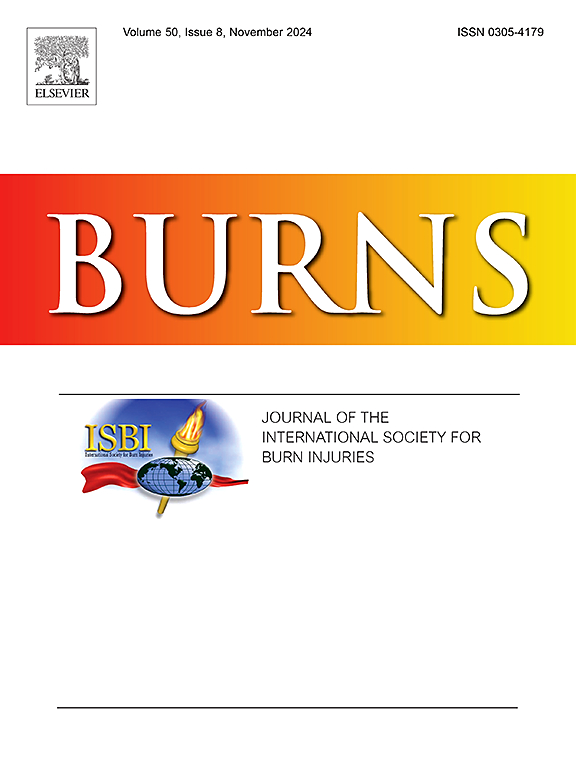与Suprathel®相比,使用鱼皮(Kerecis Omega3 wound®)后,加速酶清除深层真皮烧伤伤口的伤口愈合
IF 3.2
3区 医学
Q2 CRITICAL CARE MEDICINE
引用次数: 0
摘要
最近的研究表明,通过使用酶清创,烧伤的长期疤痕显着减少。在深层皮肤烧伤的酶清创后,有许多创面敷料可以提供足够的创面环境和理想的条件来快速愈合。在德国烧伤中心,Suprathel®主要用于此目的。自2019年以来,从鱼皮中提取的替代品Kerecis Omega3 Wound®已被用作烧伤药物的替代品。因此,我们进行了一项单中心前瞻性、开放性、比比性和个体内临床研究,以获得使用Kerecis Omega3 Wound®的初步经验,建立治疗算法,并比较Suprathel®和Kerecis Omega3 Wound®在酶清创后治疗深部皮肤烧伤的伤口愈合、渗液和疼痛方面的效果。对手和足的深层皮肤烧伤进行酶清创后,伤口分为两个区域:一个区域用Suprathel®治疗,另一个区域用Kerecis Omega3 Wound®治疗。应用后第2、4、8、12、16、24和48天更换敷料并检查伤口。由此,获得了Kerecis Omega3 Wound®处理的初步经验,并记录了伤口愈合、感染、渗出和疼痛。在2022年1月1日至2023年10月1日期间,治疗了22例年龄在18岁至83岁之间的深部皮肤烧伤患者。所有病例均取得满意的结果;没有患者需要在皮肤移植后进行第二次清创。使用Kerecis Omega3创面后的平均愈合时间为17天(最短8天,最长25天),而使用suprathel区域的平均愈合时间为23天(最短12天,最长42天)。两组均未见感染。在整个伤口愈合过程中,Kerecis Omega3 wound组的渗出明显高于Suprathel组,而疼痛程度无显著差异。换药的处理、伤口愈合进展的评估和敷料水分水平的调节是障碍,只能通过烧伤外科医生的适当经验来克服。特别是湿度的调节对伤口愈合的进展有重要的影响。根据这些参数,鱼皮的愈合过程非常不同,从早期溶解成所谓的“活性污泥”,到伤口敷料干燥形成痂,并在那里停留数周。然而,在所有22例患者中,治疗导致伤口自发愈合和满意的结果,而无需植皮或其他外科手术。Kerecis Omega3 Wound®使用安全,适用于酶清创后深层皮肤烧伤创面的治疗。与使用Suprathel®相比,它的应用可以加速伤口愈合,然而,由于伤口愈合过程中伤口外观的不同,高度的用户体验是必要的。Kerecis Omega3 Wound®可能有助于改善酶清除深层皮肤烧伤创面后的疤痕。因此,Kerecis Omega3 Wound®和Suprathel®的长期疗效比较仍有待研究。本文章由计算机程序翻译,如有差异,请以英文原文为准。
Accelerated wound healing of enzymatically debrided deep dermal burn wounds after the use of fish skin (Kerecis Omega3 Wound®) in comparison to Suprathel®
Recent studies have shown that long-term scarring from burns is significantly reduced through the use of enzymatic debridement. Following enzymatic debridement of deep dermal burns, numerous wound dressings are available that provide an adequate wound environment and ideal conditions for rapid wound healing. In German burn centres, Suprathel® has mostly been used for this purpose. Since 2019, the alternative Kerecis Omega3 Wound®, which is derived from fish skin, has been used as an alternative in burn medicine. Therefore, we conducted a single-centre prospective, open, comparative, and intra-individual clinical study to gain initial experience in the use of Kerecis Omega3 Wound®, establish a treatment algorithm and compare Suprathel® and Kerecis Omega3 Wound® in the treatment of deep dermal burns after enzymatic debridement with respect to wound healing, exudation and pain. After enzymatic debridement of deep dermal burns of the hand and foot, wounds were divided into two areas: one was treated with Suprathel® and the other with Kerecis Omega3 Wound®. Dressing changes and wound checks were carried out on days 2, 4, 8, 12, 16, 24, and 48, after application. With this, initial experience concerning the handling of Kerecis Omega3 Wound® was gained and wound healing, infection, exudation, and pain were documented. In the period from January 1, 2022, to October 1, 2023, 22 patients between the ages of 18 and 83 years with deep dermal burns were treated. Satisfactory results were obtained in all cases; no patients had to undergo a second debridement followed by skin grafting. Mean healing time after the use of Kerecis Omega3 Wound was 17 days (min 8 days, max 25 days) whereas it was 23 days (min 12 days, max 42 days) in the Suprathel-Areas. No infections were observed in both groups. Exudation throughout the wound healing process was significantly higher in the Kerecis Omega3 Wound group than in the Suprathel group, whereas no significant differences in pain levels were documented. The management of dressing changes, the assessment of the progress of wound healing and adjusting the level of moisture in the dressings were obstacles, which could only be overcome by appropriate experience of the burn surgeon. In particular, adjusting the degree of moisture had a major influence on the progress of wound healing. Depending on these parameters, very different healing processes of the fish skin, from early dissolution into the so-called “active slough”, to the drying out of the wound dressing to form a crust and remaining there for several weeks. In all 22 patients, however, the treatment led to spontaneous wound healing and satisfactory results without the need of skin grafting or other surgical procedures. Kerecis Omega3 Wound® is safe to use and suitable for the treatment of deep dermal burn wounds following enzymatic debridement. Its application leads to accelerated wound healing compared to the use of Suprathel®, however, owing to the different courses of the external appearance of the wound during wound healing, a high degree of user experience is necessary. Kerecis Omega3 Wound® might be useful to improve scarring after enzymatically debrided deep dermal burn wounds. Thus, a comparison between Kerecis Omega3 Wound® and Suprathel® concerning their long-term results is still pending.
求助全文
通过发布文献求助,成功后即可免费获取论文全文。
去求助
来源期刊

Burns
医学-皮肤病学
CiteScore
4.50
自引率
18.50%
发文量
304
审稿时长
72 days
期刊介绍:
Burns aims to foster the exchange of information among all engaged in preventing and treating the effects of burns. The journal focuses on clinical, scientific and social aspects of these injuries and covers the prevention of the injury, the epidemiology of such injuries and all aspects of treatment including development of new techniques and technologies and verification of existing ones. Regular features include clinical and scientific papers, state of the art reviews and descriptions of burn-care in practice.
Topics covered by Burns include: the effects of smoke on man and animals, their tissues and cells; the responses to and treatment of patients and animals with chemical injuries to the skin; the biological and clinical effects of cold injuries; surgical techniques which are, or may be relevant to the treatment of burned patients during the acute or reconstructive phase following injury; well controlled laboratory studies of the effectiveness of anti-microbial agents on infection and new materials on scarring and healing; inflammatory responses to injury, effectiveness of related agents and other compounds used to modify the physiological and cellular responses to the injury; experimental studies of burns and the outcome of burn wound healing; regenerative medicine concerning the skin.
 求助内容:
求助内容: 应助结果提醒方式:
应助结果提醒方式:


